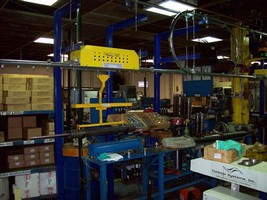Modular Conveyor System optimizes operator control, comfort.
Press Release Summary:

Designed to conserve plant space, powered C-250 Over/Under enclosed track conveyor system has support columns that allow materials to flow into area and give maintenance personal access to existing machines. Carrier design accommodates Cardwell 2300-DJ Slack Adjuster, and lift assist device at each workstation reduces physical requirements for operators. Other features include safety zone operation, touchscreen control panel, safety relays, and foot switches.
Original Press Release:
New Pacline Conveyor System Puts the Brakes on Manual Handling
Cardwell Westinghouse is a company whose history goes back over 100 years. The original Westinghouse Air Brake Company was founded by George Westinghouse in 1869. Westinghouse developed the first automatic air brake system that was installed on a Pennsylvania Railroad passenger train in 1872. The efficiency of this new system greatly improved the safety and popularity of rail transportation in North America.
This tradition of improving safety and productivity is evident today in everything they do at Cardwell. Recently, John Olavarria, warranty and reliability engineer for Westinghouse, headed the productivity improvement process for the production line of their 2300 DJ self adjusting slack adjuster. The slack adjuster is an important part of the body mounted brake systems used on railroad cars. The slack adjuster helps ensure brake performance by accurately adjusting for brake shoe wear that occurs over time. At Cardwell the production of the slack adjuster from raw material to fully assembled, finished product takes place on one line.
As Olavarria began to reconfigure the production line, it became obvious that major changes were required at the assembly stage.
Manual conveyor system was inefficient and unsafe
The existing conveyor system used for assembly of the slack adjuster was a manual free trolley conveyor. The existing carriers on the conveyor line were big, bulky, heavy and becoming damaged from the manual lifting of parts onto the carriers.
Here's how the old conveyor system worked:
The operator would manually lift the parts into the holding basket on the carrier. The operator would then push the loaded carrier from workstation to workstation with a manual voice notification that the carrier was coming. As you can easily imagine, this made it extremely dangerous due to the size and weight of the parts on the basket. Even the basket itself could seriously injure the person down stream.
The steel structure of the existing conveyor was not efficiently laid out. Designed as a continuous loop, additional unused track had been installed behind the production line in order to complete the track loop.
Modifying the existing conveyor system would have been difficult due to the amount of welding that would be required. The existing conveyor track sections would have to be welded together and the track would need to be welded to the new supports.
Another issue with the manual conveyor system was that cycle time between workstations was not consistent. If one assembler finished early they would simply push the basket to the next station, which often created a back up in that next operator's work area. If one operator fell behind there was no way to tell if they had missed the production rate until the next hour and there was also no way to control the transfer rate of the baskets.
In addition to the safety concerns of this system, there was also significant physical strain imposed on the operators. Not only did they have to push and catch the heavy, moving conveyor baskets but they were also required to lift the 50lb slack adjuster onto and off of the basket!
New system must improve safety and reduce floor space
Olavarria set some criteria for the new assembly conveyor, it must:
- address the safety concerns when moving the carriers between operators
- be easy to load and unload in order to reduce operator fatigue and possible injury,
- be controllable and time based
- minimize floor space used
Olavarria contacted Pacline Overhead Conveyors, to discuss Cardwell's requirements.
The Cardwell team involved in the new layout for the production line included Olivarria, Tom Hankes (Operations Manager), Dave Barajas (Maintenance Manager) and Brian Bodza (Quality Performance Systems team member).
It was determined that the new production process would consist of two sub assembly tables and one final assembly table in line with one another. The lean reasoning behind the three assembly tables was to more evenly divide the manual work load since the assembly process took the longest time and also to reduce the work in process (WIP) of parts since now the parts that are machined in the location are assembled right there instead of having to travel down stream to a final assembly table.
In addition, since the assembly baskets needed to move only back and forth between the tables there was no need for a continuous loop in the conveyor system that went around the production cell - this change would save considerable floor space.
After understanding the project objectives Robert D'Alesio, project engineer at Pacline Overhead Conveyors recommended a solution.
The PACLINE solution:
Powered Over/ Under Conveyor System with a touch screen control panel.
D'Alesio established three major components for the project: the conveyor layout, the carrier design, and the control system.
Over/Under conveyor design conserves plant space
The area where the new conveyor was to be installed had to be very carefully considered due to the restricted space. Since the old continuous loop type conveyor was deemed unnecessary for the assembly job and it took up valuable space in the production area, D'Alesio recommended using the Pacline powered C-250 Over/Under enclosed track conveyor system.
Support columns were placed in specific areas that would allow materials to flow into the area and to give the maintenance personal access to the existing machines. In some areas the existing building columns were utilized for support, further conserving floor space.
Solidworks used in carrier design process
Next, sample parts were given to Pacline to come up with a new carrier design that would accommodate the Cardwell 2300-DJ Slack Adjuster at the various stages of assembly as well as the various parts that had to be transported. Pacline generated the carrier design using their Solidworks software. Solidworks allowed Cardwell to visualize the carrier in a three-dimensional model.
Once the design was approved, the carriers were fabricated and tested for strength and durability at Pacline's facililty.
Later, Cardwell designed a lift assist device at each workstation to prevent the operators from lifting the parts onto the carriers. This significantly reduced the amount of physical activity required of these operators. Due to the flexible design of the carrier, this lift assist device was possible.
Touch screen control panel ensure accurate and adjustable cycle times
Finally, Cardwell and Pacline met to determine the programming needs for this project. Pacline designed and programmed a control panel that would allow easy change over for cycle time adjustment, as well as lock out features to ensure the proper personal would be the only ones accessing the control panel. This was done by a numeric password accessed on the touch screen display panel.
The control panel housed the two Allen Bradley Powerflex Variable Frequency Drives that controlled the various speeds. From the control panel door one could view the conveyor status and faults and adjustments could be made to the cycle time at each workstation and to the overall cycle time. The control panel also included a warning horn to alert the operator before the conveyor started to move.
Safety relays were also installed on each conveyor system to increase the safety of the operators and the conveyor system. These relays worked by sensing the additional amperage needed to power the conveyor when the conveyor runs into an object in its path. Once the amperage goes over the specified limit it shuts down.
Foot switches were also incorporated at each workstation allowing the operators to stop and start the conveyor while keeping their hands free.
In addition to the safety relays, the conveyor carrier was programmed to stop at a so called 'safety zone' outside of the operators work area. Once the operator was ready for the conveyor he/she would hit the foot pedal and the carrier would move into a load/unload zone where the operator could load and unload the part and/or parts. With this feature, the only way that the carrier would be in the path of an operator is when he/she was alert and ready.
Modular conveyor system allows for quick, trouble free installation
The entire conveyor system was setup and wired at the Pacline facility. This allowed Cardwell to get a good visual feel for what the complete system would look like. It also allowed Cardwell and Pacline to debug and correct any issue with the system before implementation into the production line and to prevent any unnecessary down time in production.
Important to the success of the entire project, says Olavarria "was that the Pacline conveyor system was done as a turnkey operation. The conveyor equipment was fully assembled and tested offsite. And in fact, when one error was identified in the testing, it was corrected before the equipment was approved for installation."
For Cardwell the entire process of taking down the old system and having the new one up a fully operational took only 2 ½ days. Installation took one day and all programming was done in less than a day. For the conveyor project Olivarria was assisted by Dennis Davila Jr. from Cardwell.
Olavarria commented that, "this was the first project he had worked on that had absolutely no glitches".
Today Cardwell Westinghouse continues to be a leader in rail equipment technologies designed to improve safety and productivity in the transportation industry. Cardwell Westinghouse is a division of Wabtec Corporation (www.wabtec.com).




